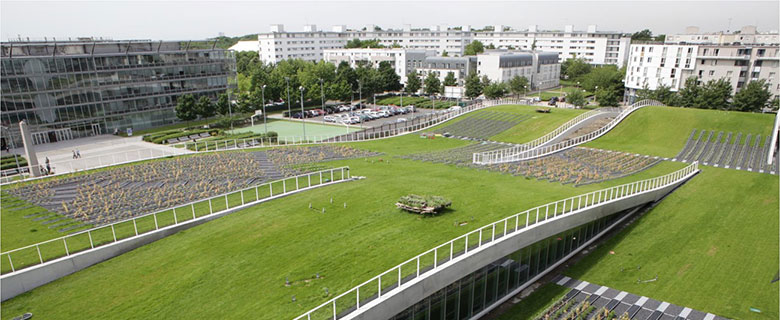Quality of life in urban areas is already compromised by air, water and noise pollution. However, climate change threatens the services essential to urban living. Moreover, on current urban population growth trends, the impacts of climate change can only get worse. More than half of the world’s population – around 54 % – already live in urban areas and by 2050, the global urban population is expected to reach 6.4 billion. This population growth will test the already stretched water, food and energy resources that cities depend upon, to breaking point.
The dual challenge – Adapting to Climate Change and Urbanization: A focus on London
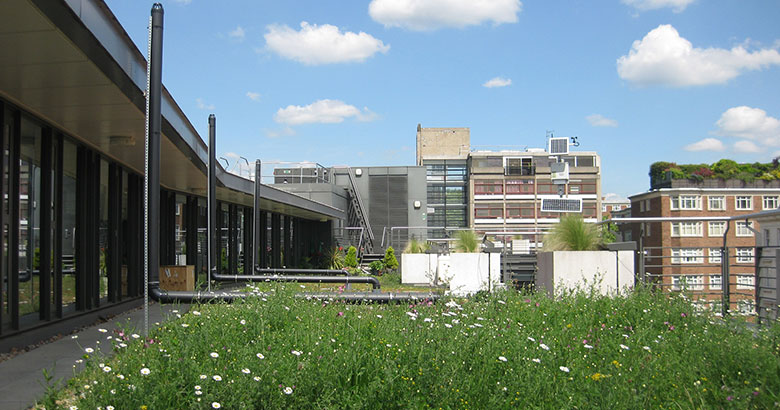 BGD test site: Green Roof at Imperial College LondonLondon’s Victorian sewer system is designed to capture both London’s stormwater and the sewage its inhabitants produce each day. However, it’s being increasingly overwhelmed by intense rainfall events, the effects of which are amplified by London’s rising population. Greater London’s population is predicted to rise from 8.2 million, in 2011, to 11.3 million by 2050.
BGD test site: Green Roof at Imperial College LondonLondon’s Victorian sewer system is designed to capture both London’s stormwater and the sewage its inhabitants produce each day. However, it’s being increasingly overwhelmed by intense rainfall events, the effects of which are amplified by London’s rising population. Greater London’s population is predicted to rise from 8.2 million, in 2011, to 11.3 million by 2050.
Thames Water are about to spend £4.2 billion (at 2011 prices) on the Thames Tideway Tunnel. This will contain overflows of sewage from London’s combined sewer overflows. Adapting to climate change via such costly approaches, which yield only one or two benefits, is common. The carbon footprint of such interventions is, moreover, often large. Their construction and even their operation – as is the case, for example, of air conditioners used to cope with heat waves – can be highly energy and materials intensive.
The Blue Green Dream – The multiple benefit approach to urban climate change adaptation
The Blue Green Dream (BGD) is a multi million Euro, Climate KIC Innovation project, founded in 2012. Its mission? To use the services that vegetation provides to not only futureproof cities against climate change, but moreover, deliver a healthier, greener, more liveable urban environment. A truly multi-functional approach to climate change adaption. So how is this achieved? Through the use of Blue Green Solutions.
Blue Green Solutions: What are they and what do they deliver?
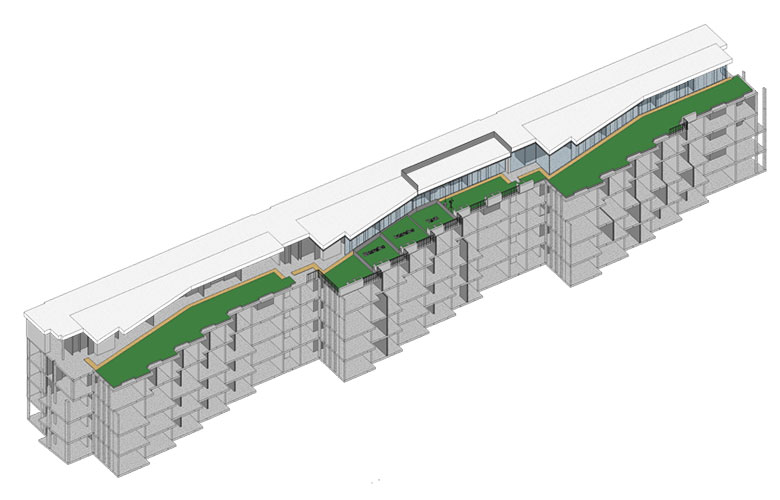 Building Information Modelling (BIM) System for visualising and simulating the effects of green facades on building energy performanceBlue Green Solutions (BG Solutions) are at the heart of the BGD’s eco-innovative approach to urban climate change adaptation. They are attained by integrating (synergizing) urban water (blue) systems with green (vegetated) infrastructure (e.g. green roofs, urban trees, rain gardens).
Building Information Modelling (BIM) System for visualising and simulating the effects of green facades on building energy performanceBlue Green Solutions (BG Solutions) are at the heart of the BGD’s eco-innovative approach to urban climate change adaptation. They are attained by integrating (synergizing) urban water (blue) systems with green (vegetated) infrastructure (e.g. green roofs, urban trees, rain gardens).
BG Solutions utilize the Ecosystem Services (the contributions made to human well-being by ecosystems – Millennium Ecosystem Assessment, 2005) provided by vegetation to deliver multiple urban benefits. These benefits include: food and biodiversity provision; reduction of urban heat islands; mitigation of air, noise and water pollution; carbon storage; thermal insulation for buildings; improvements in human health and wellbeing; protection against extreme weather events (climate change).
Green Infrastructure: the current challenges
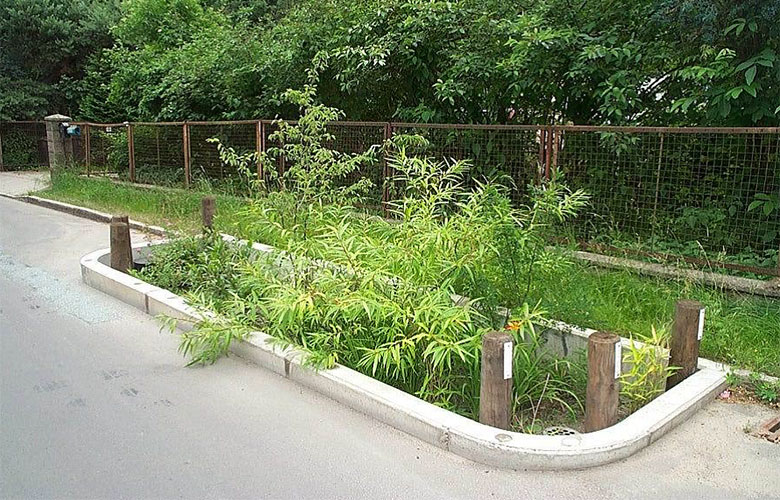 The Innodrain system developed by BGD partner IPS (Sieker) for storing and treating rainfall run-off from roadsIt is becoming widely understood that green infrastructure can deliver urban benefits, especially in relation to flood management, with the Innodrain system being an example of a Sustainable Urban Drianage System. Urban floods are caused by excessive runoff from water-impermeable surfaces – roofs, roads and pavements – into stormwater systems. By carpetting urban surfaces with greenery, stormwater can be locally detained and moreover, filtered, via the plant root network and soil media. Hence, reducing the strain on the stormwater system.
The Innodrain system developed by BGD partner IPS (Sieker) for storing and treating rainfall run-off from roadsIt is becoming widely understood that green infrastructure can deliver urban benefits, especially in relation to flood management, with the Innodrain system being an example of a Sustainable Urban Drianage System. Urban floods are caused by excessive runoff from water-impermeable surfaces – roofs, roads and pavements – into stormwater systems. By carpetting urban surfaces with greenery, stormwater can be locally detained and moreover, filtered, via the plant root network and soil media. Hence, reducing the strain on the stormwater system.
However, the full potential of green infrastructure installations, such as green roofs, is rarely achieved. Why? Because their planning and design usually does not take full consideration of their interactions with both the local environment and blue infrastructure such as water storage tanks. This is the crucial element of Blue Green Solutions.
Achieving the Blue Green Dream: Our tools and services
The BGD consortium, under the leadership of Imperial College London, is producing a range of tools and services to help planners, architects and engineers maximize the benefits of blue green infrastructure and hence deliver Blue Green Solutions. These tools are designed to help plan BG Solutions and moreover, to map and optimize the beneficial (synergistic) interactions between green infrastructure, blue infrastructure and the local environment.
Blue Greening the world
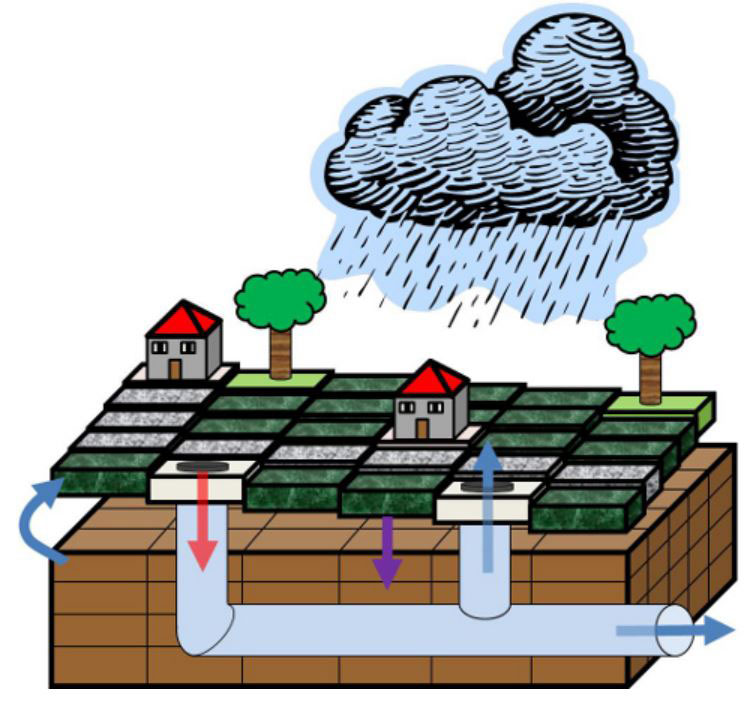 Multi Hydro – modelling tool for urban hydrological cycles plus simulation and visualization of climate change scenarios & benefits of BG solutions.Within the EU, the BGD already has 13 BG sites to: 1) demonstrate the BGD concept: 2) monitor and collect data on the performance of BG infrastructure/BG Solutions. These sites include inclined green roofs plus an intelligent cistern for managing rainwater storage in Berlin, a bioswale and an urban pond in Utrecht, the state-of-the art green roof experimental facility at Imperial College London, plus the 10,000 m2 Blue Green Wave at Ecole Nationale des Ponts ParisTech. For more information on all test sites, see here.
Multi Hydro – modelling tool for urban hydrological cycles plus simulation and visualization of climate change scenarios & benefits of BG solutions.Within the EU, the BGD already has 13 BG sites to: 1) demonstrate the BGD concept: 2) monitor and collect data on the performance of BG infrastructure/BG Solutions. These sites include inclined green roofs plus an intelligent cistern for managing rainwater storage in Berlin, a bioswale and an urban pond in Utrecht, the state-of-the art green roof experimental facility at Imperial College London, plus the 10,000 m2 Blue Green Wave at Ecole Nationale des Ponts ParisTech. For more information on all test sites, see here.
The BGD tools, services and know-how have already been applied in the planning of new developments, including the University of Zagreb’s Borongaj Campus (Croatia) and the Holland Plain residential area in Singapore. The BGD is also working with Climate-KIC to produce learning materials for the on-line Innovation Primer learning hub. The spin-out company Blue Green Global created by the BGD PI, Prof. Cedo Maksimovic, is now actively engaged in consultancy work and, moreover, contracts have been secured for services delivered through the Multi-Hydro, AST and UWOT tools.
Source: Climate KIC-Blog | 27 July 2015

